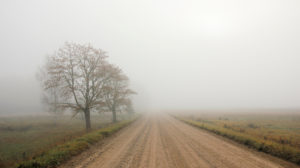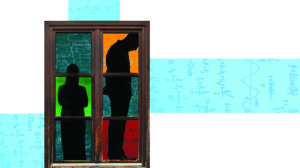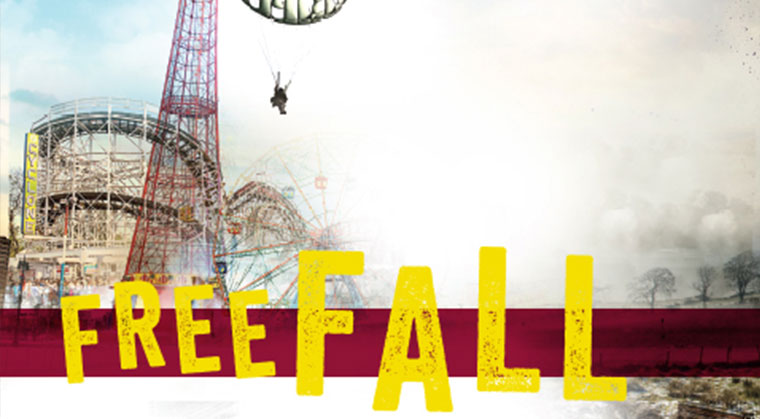Jumping Into Freefall: An Author Looks Back

Freefall took me 12 months — and 25 years — to write. Now that it’s over, while other old and new responsibilities bang at my door, I’ll ignore the knocking for a bit and share a short retrospective on life during Freefall
F
arewell Abie! Shalom Annie! And goodbye to Moe and Rob and Yeruchum and Harry and Reb Leibush and the Brauns and yes even Aunt Cele. Mrs. Horn I shall miss your European goodies (oh those chaluptches!).
It’s over. A year of semi-obsession. A year when my every quiet moment was filled with imaginary conversations and endless “what-if’s.” What if Moe has a Jewish friend who dies in Pearl Harbor? (I just couldn’t do it — I liked Harry too much. And yes Luigi’s death brought tears to my eyes.) What if Annie moves in with Aunt Cele and finds out her secret past? (Better: Let Rachel Levine reveal it. Too hard to believe that Annie would break with her father like that.) What if Moe has to choose between a sophisticated worldly and attractive British girl and a simple but courageous survivor he meets in a DP camp? (That was Plan A dropped because there wasn’t enough time for me to develop a new character; instead we got the mazel tov with a slightly softened Rob. Which worked better for Moe; he needs a wife as strong-willed as he is.)
This was a year when a Bais Yaakov grad who abhors violence and who came to adulthood in the height of the anti-Vietnam War days learned the ins and outs of basic training artillery attacks and how to dig a comfortable foxhole. A year when she discovered how horribly abhorrent — and how sometimes absolutely necessary — war and violence is in a world enveloped in sheker.
Unlike Moe and Abe I didn’t travel on troopships or airplanes and I didn’t have to dodge submarines or anti-aircraft flak. But though I didn’t jump out of a moving airplane it’s been quite a dizzying journey. My first full-length novel for adults. My first serial working with remorseless deadlines and unbreakable word counts. My first serious encounter with the history of World War II as seen through the experiences of American G.I.s rather than the Holocaust and with the fascinating narrative of how Torah Jewry both melded and split with American life in the 1940s.
All during this journey I longed to write a simultaneous account of what it was like to research create and write up the chronicle of the Freed and Levine families a kind of writer’s blog that would focus on my own struggles and triumphs in the wonderful challenging and sometimes frustrating world of serial writing. But the same pitiless deadlines that drove me half-mad at times — and yes that enabled me to finally realize my much-delayed dream of writing a full-length novel — kept me from recording even a single sentence on the backstory of my serial writing adventures.
So now that it’s over while other old and new responsibilities bang at my door I’ll ignore the knocking for a bit and share a short retrospective on life during Freefall.
Beginnings
Freefall took me 12 months — and 25 years — to write.
It began about a quarter of a century ago when I was reading one of Torah publishing’s earliest bestsellers the classic All for the Boss by Ruchoma Shain. You’ve probably read it her loving memoir of her father Reb Yaakov Yosef Herman and his uncompromising determination to live a fully Torah observant life in the “treifene medinah.” A beautiful story inspiring and compelling.
I read it. I enjoyed it. And then came those two words that are the foundation of almost every fictional story.
What if?
Mrs. Shain a”h made it clear that it wasn’t easy having a father who would not compromise one iota on his beliefs — and who was loudly vocal when he saw Jews putting tentative footsteps on the dangerous road of assimilation. “All my friends are doing it” — the teenage girls’ mantra — was not an acceptable argument in the Herman household. Yet though she touched on the difficulties of growing up in the atmosphere of battling for Torah she also described a home full of warmth caring and love all generously given by her father and mother.
What if? I thought. What if Rabbi Herman hadn’t shown his love for his children? What if Mrs. Herman wasn’t there for her daughter giving comfort and understanding when the family’s dedication to Yiddishkeit made the going rough for a young American girl? What if young Ruchoma hadn’t understood the reasons for the sacrifices being demanded of her?
Somewhere in the recesses of my brain an image appeared — a man uncompromising in his dedication to Torah. A man who loved his children deeply but who was unable to express that love. A family with no mother to dry a daughter’s tears when she was forced to dress differently from her friends or to hug a son who was embarrassed by his peyos. Two orphans with no Mamma to explain why the demands of Torah life were worthwhile and would ultimately bring joy.
A rebellious boy and a girl determined to love being raised by such a father.
They had no names yet this man and his children. They were just dim figures waiting to come to life.
It took close to three decades.
Getting Started: Time and Place and Metaphors
One day, suddenly, the father and his two children burst out of the neurons where they’d been quietly snoozing and strolled into my consciousness. For a variety of reasons, it seemed the time had come for me to write my long-delayed novel. Some emails, a few phone conversations with Bassi (always a pleasure), and then — excitement! panic! — I was scheduled to write a serialized historical novel for Family First, debuting Pesach.
So I had a time frame and three vague characters. I needed plotlines, more characters, endless research into a war I knew little about, more endless research about the home front, and a setting.
But first, I needed time.
I had a job I loved, which demanded my attention throughout the day, a busy family life, and all the many responsibilities of modern living. My schedule was already overly full. When in the world would I find time to keep up with a non-negotiable weekly deadline?
That’s when I learned the first lesson of many that this project would teach me: When there’s no time, you can make time.
Like Annie and Mrs. Horn, I learned to ration, not flour and eggs, but time. Swimming? Expendable. As part of the war effort, Americans used “oleomargarine” in place of butter; I would substitute my local grocery for the supermarket, with its endless aisles and time-wasting checkout lines, and save an hour a week. You don’t realize how much time you waste on Internet news sites until you’ve given them up. Add a total lack of social life, a lot of store-bought Shabbos foods, and — hardest of all — an alarm clock set for an hour before my circadian rhythms were ready for its shrill ring, and I had found the time.
The setting? That was easy. When I was growing up we lived in landlocked Boro Park, and Coney Island was my family’s summer destination for years. My memory was packed with vivid scenes of the crowds on the boardwalk, the burning smell of the elevated train, with its ceiling fans pushing the steamy air around us, and, of course, the sound of screaming on rollercoasters. More than simply a treasured memory, Coney Island, I realized, with its manic emphasis on artificial thrills and superficial enjoyment, would serve as a marvelous metaphor for the American life that so terrified Yeruchum and tempted his children.
And wait! The Parachute Jump, that cheerful, tacky Coney Island icon, would be the perfect metaphor for the war, as it played out on the home front. And — yes! I’ll make one of the characters into a paratrooper. We’ll call him… call him… Abe! Perfect — like his father, Avraham Avinu, he will be a man looking for his Creator and finding him.
Okay, I’ve got a setting and a historical time frame. Names! I need names. Abe, I’ve already envisioned. For the family — Freed. The children are looking for freedom. Yeruchum (who clearly needs Hashem’s rachamim when it comes to dealing with his family) knows that true freedom comes from Torah, but he’s incapable of teaching that to his children, they’ll have to find out for themselves. The children will have good Jewish names, but they will think of themselves as Americans. Thus Moishe Baruch becomes Moey and Chanaleh, Annie.
And… I’ll put them all together in a hotel, a boarding house with endless possibilities for dramatic confrontations and eccentric characters.
Piece by piece, metaphor by metaphor, a novel began to take shape.
Abe, Harry, and Hat Brims
I like to believe that, though there’s a notable absence of therapists, shidduch crises, overcrowded Bais Yaakovs, and all the other issues of the 21st century Torah-observant world, Freefall and other historical novels can still speak to our concerns. Though most of us are not jumping out of airplanes, we’re all dealing with family relationships. There are fathers out there today who, like Yeruchum, find it hard to communicate with their children. There are sons, like Moey, who chafe at restrictions and discipline. Annie’s dilemma over whether to put the personal satisfaction she enjoys in the Navy Yard, as well as her contribution to the war effort, before the well-being of two children is not that different from what many (most?) women face today.
And even when attitudes and circumstances have changed, perhaps we can still learn some lessons from the recent past.
Take Annie and Abe’s marriage.
One day, about halfway through the story, I met a woman in the grocery. She told me, a gleam in her eye: “I know how you’re going to end the serial.”
Since at that point I was still mulling over whether Abe would become a POW, and I hadn’t a clue what to do with Moe and Rob, I was intrigued.
“So,” I said, “tell me how I’m ending the serial.”
“Abe is going to die,” she said triumphantly, “and Annie will marry Harry!”
Of all the possible plot twists — and there were many — that was one that had never occurred to me. Though I didn’t plan out most of the novel, the final scene, where Abe heals and discovers the life he wants to lead as he drifts down from the Parachute Jump — with Annie awaiting him firmly on the ground — was absolutely clear to me from before I’d even written a single chapter.
Yet I discovered that the Death of Abe/Marriage to Harry scenario was quite popular. Several women suggested it to me, and it was even discussed on some frum public forums. The feeling was: Annie is so much more religious than Abe, Harry is heading to where Annie is, let them get married.
I must admit, though I never set out to write a novel with a “moral,” I wouldn’t object if our world could learn a lesson from the shidduchim of the recent past. Annie had her red lines: She wouldn’t marry Abe if he didn’t keep Shabbos, put on tefillin, want a kosher and Jewish home. But though he wasn’t the ben Torah she’d imagined, she saw in him traits of menschlichkeit, caring, and a love of adventure that spoke to something within her. The color and size of his hat brim didn’t seem to her that important a factor in her life’s happiness.
Yes, there are definitely things we can learn from Annie and Abe.
Next?
I admit, I’ve fantasized about Dr. Abraham Levine, Pediatrician, and his lovely nurse and wife, Annie; I’ve wondered if Rabbi Moe and Rebbetzin Rob (!) could run a home for orphaned children in Manchester, and if Harry should marry a nice girl and move to the newly fledged State of Israel just in time for the War of Independence. But for now, I’m taking a break for luxuries like breathing.
Until those two words come creeping into my consciousness once again:
What if?
(Originally featured in Family First Issue 544 – Shavuos 2017 Special Edition)
Oops! We could not locate your form.







